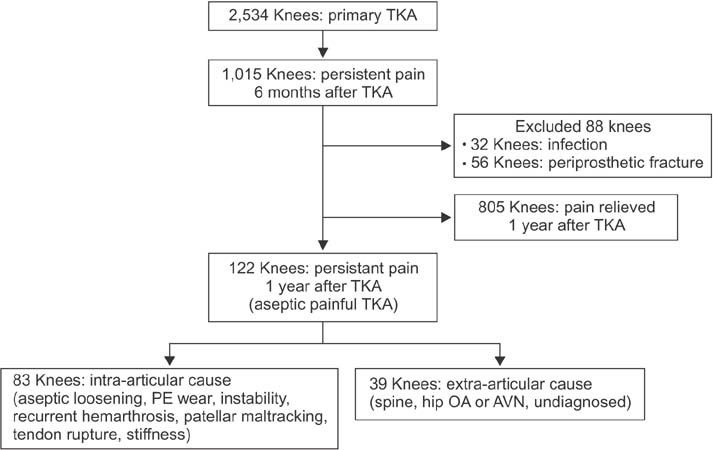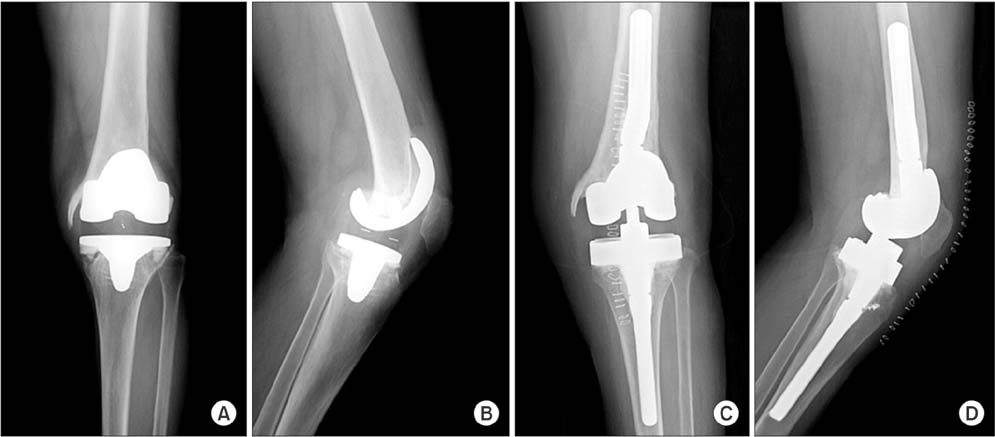Clin Orthop Surg.
2017 Mar;9(1):50-56. 10.4055/cios.2017.9.1.50.
Causes of Aseptic Persistent Pain after Total Knee Arthroplasty
- Affiliations
-
- 1Department of Orthopaedic Surgery, Center for Joint Disease, Chonnam National University Bitgoeul Hospital, Gwangju, Korea. eksong@chonnam.ac.kr
- KMID: 2412303
- DOI: http://doi.org/10.4055/cios.2017.9.1.50
Abstract
- BACKGROUND
Persistent pain after total knee arthroplasty (TKA) is dissatisfying to the patient and frustrating to the surgeon. The purpose of this study is to evaluate the aseptic causes and clinical course of intractable pain following TKA.
METHODS
Of the total 2,534 cases of primary TKA reviewed, 178 cases were classified as having aseptic persistent pain that was not resolved within 1 year after surgery. Except for the cases with periprosthetic fracture (56 knees), 122 cases of aseptic painful TKA were divided into two groups: intra-articular group (83 knees) and extra-articular group (39 knees).
RESULTS
In the intra-articular group, the main reasons for pain were aseptic loosening (n = 40), polyethylene wear (n = 16), instability (n = 10), recurrent hemarthrosis (n = 5), patellar maltracking (n = 4), tendon ruptures (n = 4), and stiffness (n = 2). In the extraarticular group, 10 knees (25.6%) were found to have nerve entrapment in the spine, 6 knees (15.4%) were found to have hip osteoarthritis or femoral head avascular necrosis. The reasons for persistent knee pain in the remaining 23 knees (59.0%) still remain elusive.
CONCLUSIONS
Persistent pain after TKA originated from pathology of extra-articular origin in a considerable number of cases in this study. Therefore, it is important to perform thorough preoperative evaluations to reduce pain resulting from extra-articular causes. Furthermore, meticulous surgical procedures and optimal alignment are required to reduce pain of intra-articular origin related to implant wear, instability, and patellar maltracking.
Keyword
MeSH Terms
-
Aged
Aged, 80 and over
Arthralgia/*etiology
Arthroplasty, Replacement, Knee/*adverse effects
Female
Femur Head Necrosis/complications
Humans
Joint Instability/complications
Male
Middle Aged
Nerve Compression Syndromes/complications
Osteoarthritis, Hip/complications
Pain, Intractable/diagnostic imaging/*etiology
Pain, Postoperative/diagnostic imaging/*etiology
Patella/physiopathology
Prosthesis Failure/adverse effects
Radiography
Figure
Reference
-
1. Bae DK, Yoon KH, Kim HS, Song SJ, Yi JW, Kim YC. The results of revision total knee arthroplasty. J Korean Orthop Assoc. 2003; 38(7):689–694.
Article2. Cameron HU, Hunter GA, Welsh RP, Bailey WH. Revision of total knee replacement. Can J Surg. 1981; 24(4):418–420.3. Bonnin MP, Basiglini L, Archbold HA. What are the factors of residual pain after uncomplicated TKA? Knee Surg Sports Traumatol Arthrosc. 2011; 19(9):1411–1417.
Article4. Lingard EA, Riddle DL. Impact of psychological distress on pain and function following knee arthroplasty. J Bone Joint Surg Am. 2007; 89(6):1161–1169.
Article5. Fehring TK, Odum S, Griffin WL, Mason JB, Nadaud M. Early failures in total knee arthroplasty. Clin Orthop Relat Res. 2001; (392):315–318.
Article6. Sharkey PF, Hozack WJ, Rothman RH, Shastri S, Jacoby SM. Insall Award paper: why are total knee arthroplasties failing today? Clin Orthop Relat Res. 2002; (404):7–13.7. Hofmann S, Seitlinger G, Djahani O, Pietsch M. The painful knee after TKA: a diagnostic algorithm for failure analysis. Knee Surg Sports Traumatol Arthrosc. 2011; 19(9):1442–1452.
Article8. Dennis DA. A stepwise approach to revision total knee arthroplasty. J Arthroplasty. 2007; 22:4 Suppl 1. 32–38.
Article9. Dennis DA. Evaluation of painful total knee arthroplasty. J Arthroplasty. 2004; 19:4 Suppl 1. 35–40.
Article10. Bader R, Mittelmeier W, Steinhauser E. Failure analysis of total knee replacement: basics and methodological aspects of the damage analysis. Orthopade. 2006; 35(9):896–903.11. Quisel A, Gill JM, Witherell P. Complex regional pain syndrome underdiagnosed. J Fam Pract. 2005; 54(6):524–532.12. Fehring TK, Murphy JA, Hayes TD, Roberts DW, Pomeroy DL, Griffin WL. Factors influencing wear and osteolysis in press-fit condylar modular total knee replacements. Clin Orthop Relat Res. 2004; (428):40–50.13. Hoshino A, Fukuoka Y, Ishida A. Accurate in vivo measurement of polyethylene wear in total knee arthroplasty. J Arthroplasty. 2002; 17(4):490–496.
Article14. Kim J, Nelson CL, Lotke PA. Stiffness after total knee arthroplasty: prevalence of the complication and outcomes of revision. J Bone Joint Surg Am. 2004; 86(7):1479–1484.15. Puolakka PA, Rorarius MG, Roviola M, Puolakka TJ, Nordhausen K, Lindgren L. Persistent pain following knee arthroplasty. Eur J Anaesthesiol. 2010; 27(5):455–460.
Article16. Perkins FM, Kehlet H. Chronic pain as an outcome of surgery: a review of predictive factors. Anesthesiology. 2000; 93(4):1123–1133.17. Cho WS, Ahn HS, Kim MY, Seol ES, Lee SW, Choi JW. Pain after total knee arthroplasty. J Korean Orthop Assoc. 2006; 41(1):129–133.
Article18. Mont MA, Serna FK, Krackow KA, Hungerford DS. Exploration of radiographically normal total knee replacements for unexplained pain. Clin Orthop Relat Res. 1996; (331):216–220.
Article19. Mandalia V, Eyres K, Schranz P, Toms AD. Evaluation of patients with a painful total knee replacement. J Bone Joint Surg Br. 2008; 90(3):265–271.
Article20. Al-Hadithy N, Rozati H, Sewell MD, Dodds AL, Brooks P, Chatoo M. Causes of a painful total knee arthroplasty: are patients still receiving total knee arthroplasty for extrinsic pathologies? Int Orthop. 2012; 36(6):1185–1189.
Article21. Dalury DF, Pomeroy DL, Gorab RS, Adams MJ. Why are total knee arthroplasties being revised? J Arthroplasty. 2013; 28:8 Suppl. 120–121.
Article22. Merle C, Brendle S, Wang H, Streit MR, Gotterbarm T, Schiltenwolf M. Multidisciplinary treatment in patients with persistent pain following total hip and knee arthroplasty. J Arthroplasty. 2014; 29(1):28–32.
Article23. Pinto PR, McIntyre T, Ferrero R, Almeida A, Araujo-Soares V. Risk factors for moderate and severe persistent pain in patients undergoing total knee and hip arthroplasty: a prospective predictive study. PLoS One. 2013; 8(9):e73917.
Article24. Lopez-Olivo MA, Landon GC, Siff SJ, et al. Psychosocial determinants of outcomes in knee replacement. Ann Rheum Dis. 2011; 70(10):1775–1781.
Article
- Full Text Links
- Actions
-
Cited
- CITED
-
- Close
- Share
- Similar articles
-
- Nerve blocks for optimal postoperative analgesia after total knee arthroplasty
- Causes and Clinical Outcomes Associated with Re-revision Total Knee Arthroplasty
- Osteolytic Lesion of the Fibular Head after Cemented Total Knee Arthroplasty
- Osteotomy of the Tibial Tubercle in difficult Total Knee Arthroplasty
- Guidelines for the Management of Postoperative Pain after Total Knee Arthroplasty




